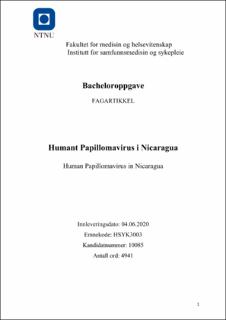| dc.description.abstract | ABSTRAKT
Introduksjon: Fagartikkelen tar for seg sykepleiernes rolle og opplevelser i møte med kvinner utsatt for HPV, hovedsakelig på lokale helsesenter og ute i feltet. Videre belyses hvilke sykepleietiltak som benyttes i forebyggingen av HPV i Nicaragua.
Metode: For å undersøke hva sykepleierne vektlegger; i møte med risikogruppen i forebygging av HPV og hvordan dette fungerer i praksis. Det ble gjennomført to kvalitative intervjuer og observasjoner i åtte uker, med sykepleiere som hadde erfaringer fra feltet. Intervjuene ble utført i mars 2020, og deretter analysert sammenfattet i to overordnede temaer; «forebyggende tiltak mot HPV» og «testing av HPV».
Resultater: Resultatene viser at tilrettelagt informasjon og opplysning, bidrar til økt kunnskap og forståelse om HPV, og dets konsekvenser ved unnvikelse av testing og videre behandling. Informantene kunne meddele at informasjonen ble gitt på flere måter, gjennom feltarbeid på helsesentre og ulike kommunikasjonskanaler. Informantene var sikre på at spredning av relevant informasjon hadde hatt en positiv innvirkning på kvinners helse og i forebyggingen av HPV og livmorhalskreft.
Diskusjon: Mangel på kunnskap og lite opplysning kan skape misforståelse og økt stigmatisering av HPV i samfunnet. Resultater viser at det forekommer et behov for å øke kunnskapsnivået både blant kvinner i risikogruppen og helsepersonell. Økt kunnskap gir kvinner trygghet for å snakke HPV, behandling og livmorhalskreft.
Konklusjon: Disse dataene viser at tilrettelagt informasjon og opplysning, kan øke kvinners kunnskap om et folkehelseproblem, slik at flere tar livmorhalsprøve. | |
| dc.description.abstract | ABSTRACT
Introduction: The purpose of this article is to explore nurses´ role and experiences, mainly in local health centers and fieldwork, in meeting with women exposed to Human Papilloma Virus in Nicaragua. Furthermore, the article will look into the different approaches and means the nurses implement, to prevent HPV.
Method: Two qualitative interviews with experienced nurses, and observations from the field were completed over a time period of eight weeks. This was done, in order to explore what nurses´ emphasize in their work of preventing of HPV in meeting with women that are in risk of beeing exposed to the infection. The interviews found place in March 2020. Findings from observations and interviews were analyzed and summarized into two main topics: «preventing measures against HPV» and «testing of HPV».
Results: Results show that facilitated information and education contribute to increase knowledge and understanding about HPV, and potential if the women do not come forward to get tested and subsequently treated. The informants described that information was given, among others, through fieldwork, health centers and a variation of communication channels. The informants were sure that the amount of relevant information spread throughout the community had a positive effect on women’s´ health and prevention of HPV and cervical cancer.
Discussion: In light of the above, lack of knowledge and information can create misunderstandings and stigma in the society regarding HPV. Results shows that there is a need for increased level of knowledge among both exposed women in the risk group and nurses. Increased knowledge can potentially give woman the security to talk about HPV, its treatment and cervical cancer.
Conclusion: Data shows that facilitated information and education can increase women´s knowledge about a public health issue, and more specifically HPV, can lead to more women getting a cervical sample. | |
